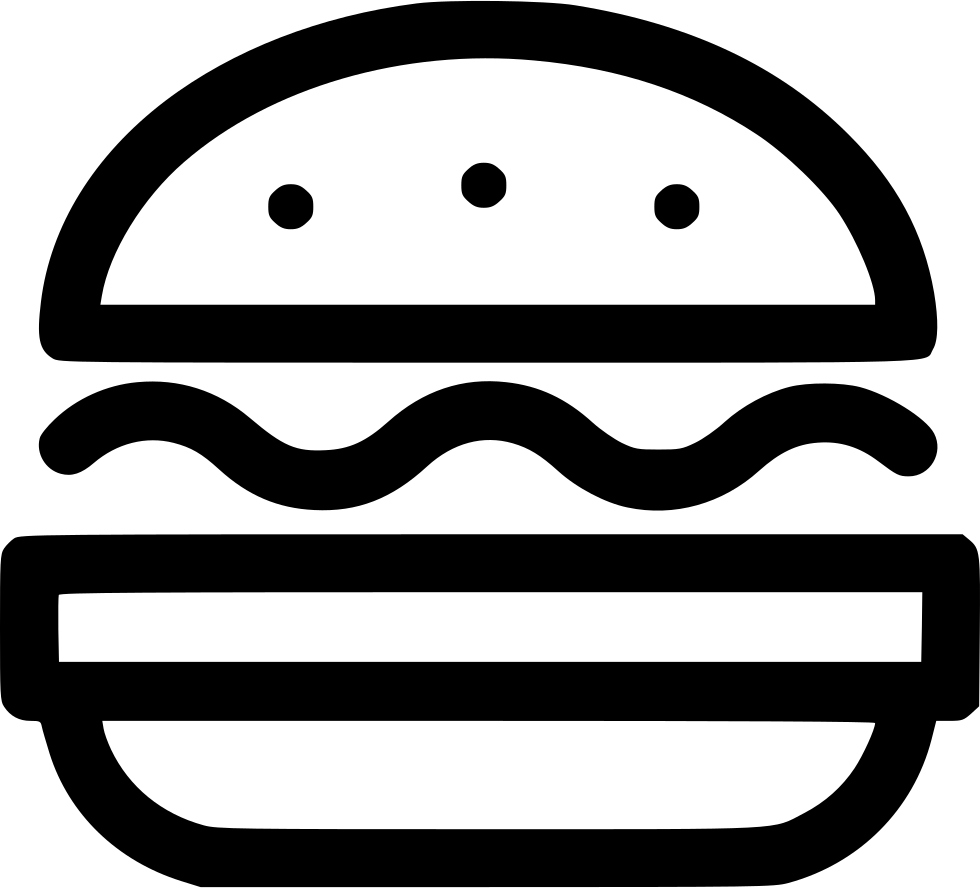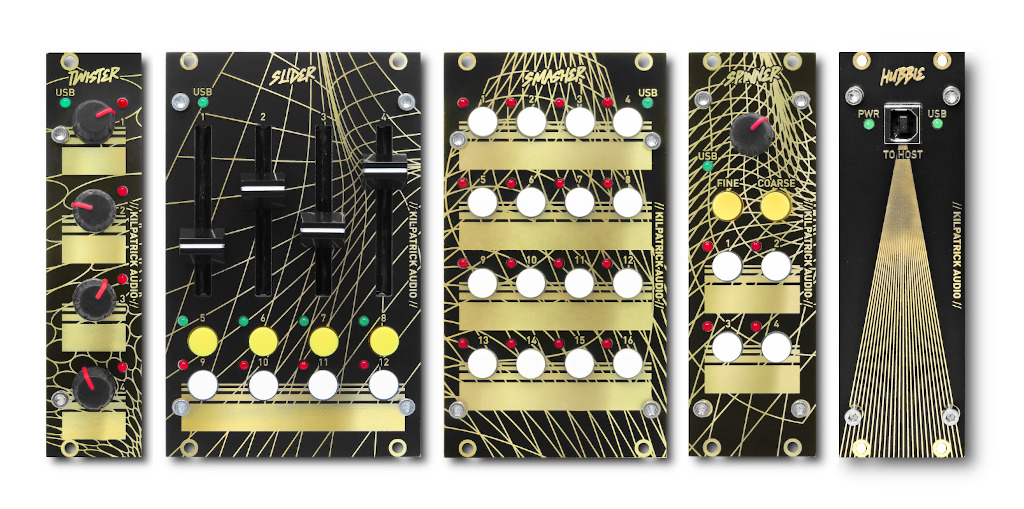
Virtue Control Series
Eurorack Modular USB Controllers for Software
Virtue Modules | VCV Rack Plugin | Manual
Computer music is getting better with every new generation of PC and Mac, and the recent proliferation of virtual modular synthesizer platforms like VCV Rack have brought modular synthesis to a whole new generation of musicians. But the hands-on appeal of physical instruments can never be imitated by a touch-screen or mouse. This is where the Virtue Control Series from Kilpatrick Audio comes in.
Eurorack Skiff-friendly
The Virtue Control products are designed as Eurorack modules and mount in any Eurorack enclosure. They are skiff-friendly with most modules being less than 26mm deep. We offer a compatible enclosure that can be used with Virtue and many other modules.
USB Powered / Plug-and-Play
All modules connect over USB to your computer and support the class compliant USB-MIDI protocol so they work with any music software with fast and simple setup. You can design your own controller setup by mixing and matching any number or type of modules together. When connected to your computer each module shows up as its name with a unique number, preventing confusion if you want to use more than one of the same type in your setup. This ensures that your configuration stays consistent when unplugging cables or going to a gig.
Full VCV Rack Integration
We are a big fan of the VCV Rack modular platform and we have released a number of modules both for free and as part of our product offerings. The Virtue Control series comes with a complete set of modules for tight integration with VCV Rack. The modules in the rack are linked to your physical Virtue modules for seamless integration. You can test out your patch and map parameters to the Virtue modules even without the hardware plugged in. You can also subscribe to the free Kilpatrick-Toolbox plugin on VCV for useful MIDI and other tools that you can use with the Virtue modules.
Virtue Control Modules
All Virtue Control Modules come with everything you need except an enclosure. We offer low-cost light-weight enclosures specifically designed for table-top use with enough depth for modules up to 44mm deep. This includes all our current Eurorack modules. Our Hubbie module is a Eurorack-sized USB 2.0 hub designed to attach up to four modules internally and provide a single cable to the computer.
Virtue Control Modules
- Twister - Four Knob Controller
- Smasher - Sixteen Button Controller
- Slider - Four Sliders with Eight Button Controller
- Spinner - Endless Rotary Encoder with Four Presets
- Hubbie - Four port USB 2.0 High-speed Hub
Features common to all modules
- USB Powered - All modules are powered off USB. This means there is no need for a Eurorack power supply in your enclosure if all you are using are controller modules. Each one comes with a short USB cable attached to the module which can be replaced or extended if you need something longer.
- Skiff-friendly - Each module is designed for minimal depth so it will fit in even the most slim enclosure. The max depth for controller modules is 26mm including hardware and cabling. (Hubbie module is 31mm deep)
- Built-in Label Area - Most USB controllers on the market today leave no room for neatly labeling controls. All Virtue Control modules come with space to label controls. They are designed for common label-maker tape sizes.
- Dimmable LEDs with Backlighting - All LEDs have controllable brightness via CC messages sent from the computer. You can also set a minimum brightness level which can help find your way in the dark.
- Internal Setting Storage - Modules have settings you can change. These settings are automatically stored internally. The VCV Rack modules that accompany the hardware will retain any settings you set from other programs so you can switch back and forth easily.
- Low Power - Unless otherwise specified all controller modules operate as low power (<100mA) devices which can be used on a bus-powered hub. This means you can plug at least four modules through a hub into your computer without any external power supplies.
- USB Status LED - A green USB status LED confidently tells you that the module is properly talking to your computer. The LED can be asked to blink which can be used to identify the module in your rack if you have a number of the same type.
Module Editor
If you want to use Virtue USB controllers with software that requires certain CC numbers or otherwise need to edit the internal settings, we have a handy WebMidi-based application you can use to do this: KVEdit Control Mapper for Virtue Modules

Twister
Four Knob Controller - 6HP
The simplest of all Virtue modules Twister offers four high-quality metal potentiometers. Each one sends out a CC message, and a CC message can also be sent to the module to control a red LED next to each knob. Map the knobs to your monitor volume or other basic parameters in your module software, or set up a few in a row to make your own matrix mixer!
Features
- Four high-quality metal shaft potentiometers
- Rugged rubberized knobs
- Each knob has a dedicated red LED which can be dimmed via MIDI
- LED backlight function to provide minimal illumination in the dark
- USB LED shows connection status and can be remotely blinked by software
- Knob autosend feature can send current positions regularly
- USB-MIDI class compliant - no drivers required
- USB bus-powered (100mA) device
- Integrated replaceable 1.5' micro USB cable with cable restraint
- Dimensions: 6HP - 30.0mm x 128.5mm x 26.0mm (WxHxD)
Availability
Price: $99 USD
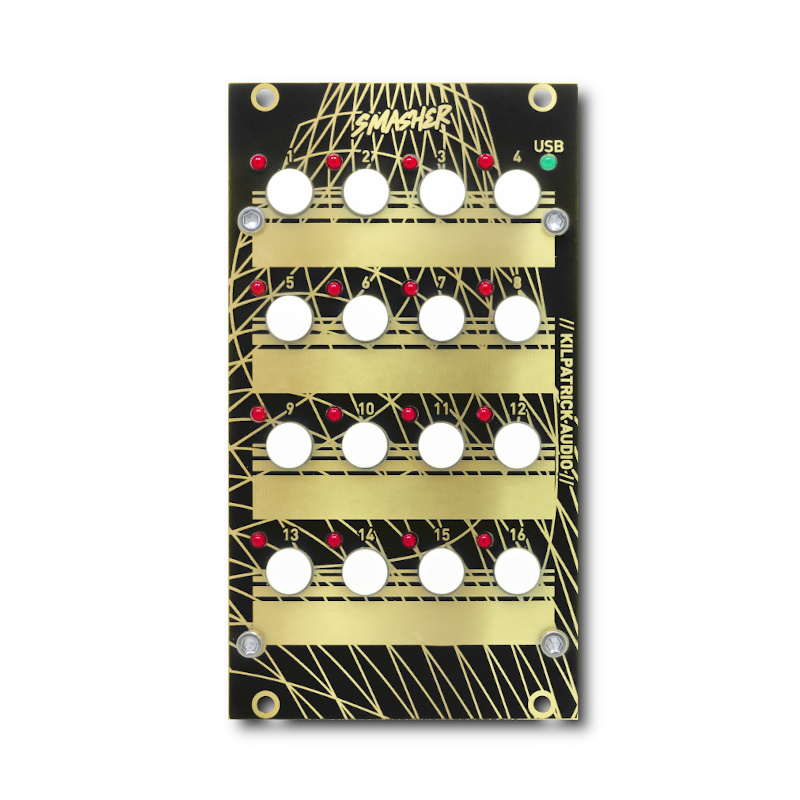
Smasher
Sixteen Button Controller - 14HP
The Smasher offers sixteen buttons that each send out their own CC message. Each button has a corresponding LED that can be controlled with the same CC message. Trigger some samples or mute and unmute parts.
Features
- Sixteen medium action (non-tact) pushbuttons
- Each button has a dedicated red LED which can be dimmed via MIDI
- LED backlight function to provide minimal illumination in the dark
- USB LED shows connection status and can be remotely blinked by software
- USB-MIDI class compliant - no drivers required
- USB bus-powered (100mA) device
- Integrated replaceable 1.5' micro USB cable with cable restraint
- Dimensions: 14HP - 70.8mm x 128.5mm x 26mm (WxHxD)
Availability
Price: $179 USD

Slider
Four Sliders with Eight Button Controller - 16HP
Resembling a simple mixer-style interface Sliders offer four high-quality 45mm slide potentiometers with large plastic caps. Beneath each slider are two buttons each with their own LED. Use Slider as a stem mixer, adjust effect parameters, mute and unmute tracks and effects sends, or whatever you can think of.
Features
- Four 45mm metal slide potentiometers with integrated dust covers
- Eight medium action (non-tact) pushbuttons
- LED backlight function to provide minimal illumination in the dark
- USB LED shows connection status and can be remotely blinked by software
- USB-MIDI class compliant - no drivers required
- USB bus-powered (100mA) device
- Integrated replaceable 1.5' micro USB cable with cable restraint
- Dimensions: 16HP - 80.9mm x 128.5mm x 26mm (WxHxD)
Availability
Price: $169 USD

Spinner
Endless Rotary Encoder with Four Presets - 8HP
Spinner offers an endless rotary control which is designed to send either relative or absolute values of four different parameters. Simply choose the parameter with one of four buttons and then adjust it up or down with the spinner. The spinner uses a 24 pulse-per-rotation mechanical encoder with detents. It is suitable for controlling stepped parameters as well as values such as volume, EQ settings, tempo, and more. The coarse and fine speed buttons can be used for more or less precision.
Features
- Metal shaft mechanical rotary encoder (24 pulse-per-revolution with detents)
- Six medium action (non-tact) pushbuttons
- Four-channel CC controller with absolute or relative position modes
- Fine and coarse speed control buttons
- LED backlight function to provide minimal illumination in the dark
- USB LED shows connection status and can be remotely blinked by software
- USB-MIDI class compliant - no drivers required
- USB bus-powered (100mA) device
- Integrated replaceable 1.5' micro USB cable with cable restraint
- Dimensions: 8HP - 40.3mm x 128.5mm x 26mm (WxHxD)
Availability
Price: $139 USD
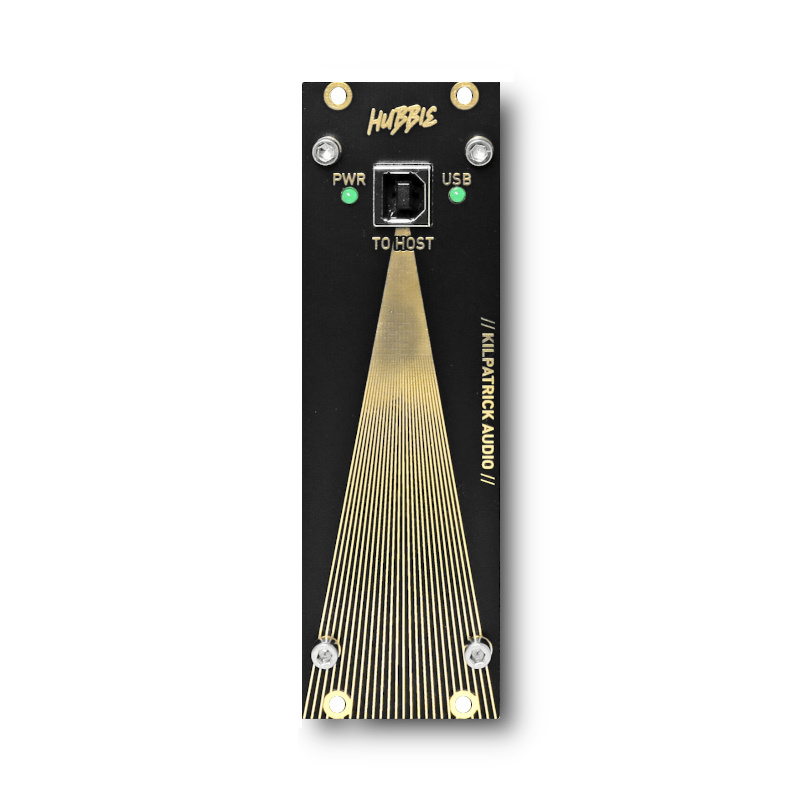
Hubbie
Four Port USB 2.0 High-speed Hub - 8HP
Hubbie is a slick four port USB 2.0 High-speed hub that mounts in a Eurorack enclosure as a standard 8HP module. It has four internal USB-A host connections that can be connected inside your case to Virtue modules. A single USB-B upstream port on the front panel connects to your computer. When powering most Virtue modules Hubbie works in bus-powered mode and can supply up to 100mA to each module. If you need higher power, simply plug Hubbie into your Eurorack power supply to provide up to 500mA per port. An internal 10 pin Eurorack power connector is used for self-power mode. Front panel LEDs show the USB and power status.
Features
- Four port USB 2.0 High-speed hub in Eurorack format
- Can be bus-powered for four devices up to 100mA each
- Can be self-powered for devices up to 500mA each
- Internal USB-A downstream ports keeps module wiring hidden
- Eurorack 16 pin power connector integrated for self powering (cable not included)
- Draws <1A at +12V in self-powered mode (depends on connected devices)
- LEDs show USB activity status and self-powered status
- USB A to B right-angle cable included
- Dimensions: 8HP - 40.3mm x 128.5mm x 30mm (WxHxD)
Availability
Price: $99 USD
Virtue VCV Rack Plugin
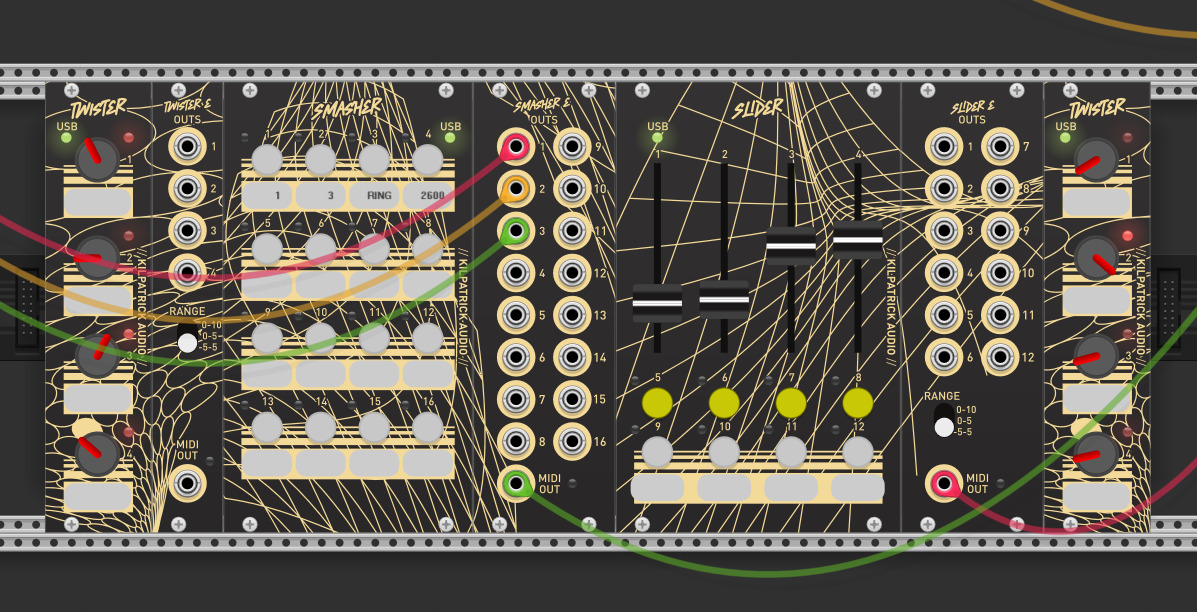
Virtue Control modules have hardware companion modules available in VCV Rack that allow seamless control of your VCV Rack patches with hands-on hardware controls. Virtue Control modules are professional-grade USB controllers perfect for the studio or on stage. You can map controls directly to any parameter within VCV Rack. The virtual modules even retain all the MIDI settings without the physical hardware present so you can edit and test your patch on the road. When you plug back in your hardware it will automatically map to the companion modules in your VCV Rack patch.
In addition to the companion modules, you can subscribe on VCV Rack to our Kilpatrick-Toolbox plugin which contains other MIDI modules you can use with Virtue modules.
Learn more about Virtue VCV Rack Modules
Availability
As of Rack version 2 we offer this plugin for free to encourage purchase of our hardware modules.
Virtue Control Module User Manual
The Virtue Control modules all work in a similar way. The common features and specifications will be outlined first, followed by specific details of each module.
General Module Usage
Virtue Control modules are class-compliant USB MIDI controllers which can be used with any MIDI software on any computer, phone or tablet which supports USB MIDI. All modules are bus-powered and are low power (100mA) devices unless otherwise specified. Actual power consumption is usually much lower and depends on LED usage, giving long run time on battery-powered setups.
Modules each have a USB LED which indicates whether the module has been properly set up by the host. This LED can be blinked by a CC message sent to the device for identification by your own software. Most controls send CC messages and most LEDs can be controlled by CC messages. The modules are designed to be as universal as possible while still having a cool look and feel.
MIDI Implementation
Internal EEPROM Storage
Where indicated some settings are stored in internal EEPROM on the module. This allows you to make changes which are remembered when the power is off. Please note that these settings are not used by the VCV Rack plugin.
Module Editor
Internal settings can be edited using this WebMidi-based application: KVEdit Control Mapper for Virtue Modules
Direct Mode
Direct mode can be used to get raw access to controls on a module regardless of any existing EEPROM settings you might be using in other programs. If you are making custom software to interact with Virtue modules you might want to use this. All internal EEPROM settings are retained when direct mode is used.
To enable direct mode simply send the Direct Mode message (depends on module) at least once per second to keep direct mode activated. No changes are made to the internal EEPROM when using direct mode. Direct mode times out automatically after approx. 5 seconds if the direct mode CC message is not received. The main features when using direct mode are as follows:
- Knobs and Sliders Autosend - The autosend functions is enabled automatically for knobs and sliders. The send interval is determined internally.
- Raw Access to Controls - Some modules like Spinner have internal functionality which is disabled in direct mode. All raw control values are sent and LEDs can all be remotely controlled.
- LED Backlight Mode - You can turn on or off LED backlight mode with a single bit. The brightness is determined internally.
- MIDI Channel - MIDI messages are sent on channel 16 when using direct mode.
Message Types
| Control Type | Message Type | Range / Notes |
|---|---|---|
| Button | Control Change (CC) | button up = 0, button down = 127 |
| Knob / Slider | Control Change (CC) | 0-127 = min to max |
| Rotary Encoder | Control Change (CC) | 63 or less = CCW, 65 or more = CW |
| LED | Control Change (CC) | 0-127 = off to max brightness |
| Heartbeat | Active Sensing | Sent from the module several times per second |
| Note: All MIDI messages are sent and received on MIDI channel 1 unless otherwise specified. | ||
Twister MIDI Mapping
| Control | Controller (CC) | Value |
|---|---|---|
| Knob 1 / LED 1 | 1 | see Message Types |
| Knob 2 / LED 2 | 2 | see Message Types |
| Knob 3 / LED 3 | 3 | see Message Types |
| Knob 4 / LED 4 | 4 | see Message Types |
| Knob Autosend Interval | 116 | 0 = off, 1-127 = 10ms to 1.27s (10ms steps) |
| Direct Mode | 117 | bit 6-1: reserved bit 0: LED backlight mode |
| LED Minimum Level | 118 | 0-127 = min to max (stored in EEPROM) |
| USB LED Blink | 119 | 0-63 = normal, 64-127 = blink for 2s |
Smasher MIDI Mapping
| Control | Controller (CC) | Value |
|---|---|---|
| Button 1 / LED 1 | 1 | see Message Types |
| Button 2 / LED 2 | 2 | see Message Types |
| Button 3 / LED 3 | 3 | see Message Types |
| Button 4 / LED 4 | 4 | see Message Types |
| Button 5 / LED 5 | 5 | see Message Types |
| Button 6 / LED 6 | 6 | see Message Types |
| Button 7 / LED 7 | 7 | see Message Types |
| Button 8 / LED 8 | 8 | see Message Types |
| Button 9 / LED 9 | 9 | see Message Types |
| Button 10 / LED 10 | 10 | see Message Types |
| Button 11 / LED 11 | 11 | see Message Types |
| Button 12 / LED 12 | 12 | see Message Types |
| Button 13 / LED 13 | 13 | see Message Types |
| Button 14 / LED 14 | 14 | see Message Types |
| Button 15 / LED 15 | 15 | see Message Types |
| Button 16 / LED 16 | 16 | see Message Types |
| Direct Mode | 117 | bit 6-1: reserved bit 0: LED backlight mode |
| LED Minimum Level | 118 | 0-127 = min to max (stored in EEPROM) |
| USB LED Blink | 119 | 0-63 = normal, 64-127 = blink for 2s |
Slider MIDI Mapping
| Control | Controller (CC) | Value |
|---|---|---|
| Slider 1 | 1 | see Message Types |
| Slider 2 | 2 | see Message Types |
| Slider 3 | 3 | see Message Types |
| Slider 4 | 4 | see Message Types |
| Button 5 / LED 5 | 5 | see Message Types |
| Button 6 / LED 6 | 6 | see Message Types |
| Button 7 / LED 7 | 7 | see Message Types |
| Button 8 / LED 8 | 8 | see Message Types |
| Button 9 / LED 9 | 9 | see Message Types |
| Button 10 / LED 10 | 10 | see Message Types |
| Button 11 / LED 11 | 11 | see Message Types |
| Button 12 / LED 12 | 12 | see Message Types |
| Knob Autosend Interval | 116 | 0 = off, 1-127 = 10ms to 1.27s (10ms steps) |
| Direct Mode | 117 | bit 6-1: reserved bit 0: LED backlight mode |
| LED Minimum Level | 118 | 0-127 = min to max (stored in EEPROM) |
| USB LED Blink | 119 | 0-63 = normal, 64-127 = blink for 2s |
Spinner MIDI Mapping
Spinner Modes
Spinner contains internal functionality to keep track of current values on each of its four channels. This setting can be set by sending a CC message. (see below) There are four modes that can be used when operating Spinner in normal (non-direct) mode:
- Relative Channels - Each of four channels can be selected. When a channel is selected a relative up or down message is sent when the encoder is turned.
- Absolute Channels - Each of four channels can be selected. When a channel is selected the absolute value (0-127) is sent when the encoder is turned.
- Relative Split - The channel buttons are disconnected from the encoder and simply send button presses and respond to LED messages. A single relative value is sent when the encoder is turned.
- Absolute Split - The channel buttons are disconnected from the encoder and simply send button presses and respond to LED messages. When the encoder is turned a single absolute value from 0-127 is sent.
| Control | Controller (CC) | Value |
|---|---|---|
| Spinner Channel 1 / Split mode | 1 | absolute: 0-127 = min to max relative: 63 = CCW, 65 = CW |
| Spinner Channel 2 | 2 | absolute: 0-127 = min to max relative: 63 = CCW, 65 = CW |
| Spinner Channel 3 | 3 | absolute: 0-127 = min to max relative: 63 = CCW, 65 = CW |
| Spinner Channel 4 | 4 | absolute: 0-127 = min to max relative: 63 = CCW, 65 = CW |
| Button 1 / LED 1 (Split Mode) | 5 | see Message Types |
| Button 2 / LED 2 (Split Mode) | 6 | see Message Types |
| Button 3 / LED 3 (Split Mode) | 7 | see Message Types |
| Button 4 / LED 4 (Split Mode) | 8 | see Message Types |
| Speed Fine Button (Direct Mode) | 9 | see Message Types |
| Speed Fine Button (Direct Mode) | 10 | see Message Types |
| Spinner Mode | 116 | 0 = relative channels 1 = absolute channels 2 = relative split 3 = absolute split (stored in EEPROM) |
| Direct Mode | 117 | bit 6-1: reserved bit 0: LED backlight mode |
| LED Minimum Level | 118 | 0-127 = min to max (stored in EEPROM) |
| USB LED Blink | 119 | 0-63 = normal, 64-127 = blink for 2s |
Firmware Updates
Periodically there may be updated firmware available for Virtue Control modules to fix bugs or add new features. All updates are available exclusively through our WebMidi-based update tool. Please see the Firmware Updates page for details. If no firmware is currently listed then there is no update available beyond the version that came with the module. We accept bug or feature requests but do not have a fixed release schedule for new versions.

